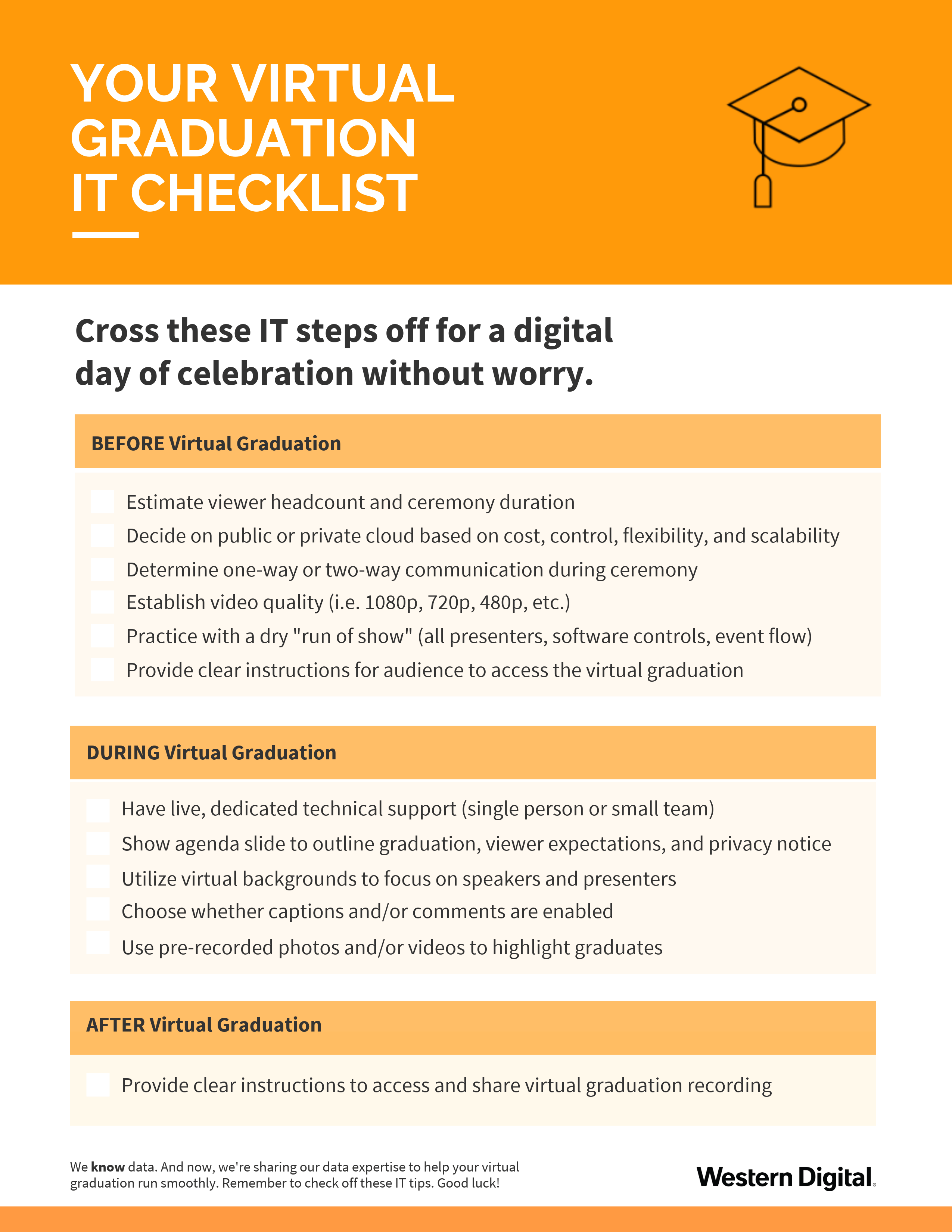Virtual Graduation Checklist from Our IT Experts
Virtual Graduation Dos and Don’ts
In our previous blog post, we asked a middle school, high school, and community college teacher to share their experiences and best practices teaching their students using remote learning. Now, we turn our attention from students studying to students graduating. As Vice President of Global Infrastructure and IT Operations, my insights stem from leading teams that have live-streamed global town halls to thousands of viewers around the world.
In this article, I’ll lay out a checklist for your IT team to prepare for your big graduation day, and give your graduates the memorable experience that they deserve.

Download your virtual graduation IT checklist here >>

People are streaming video to their mobile devices, personal computers, and TVs now more than ever. That includes video conferencing with clients and colleagues, catching up with the latest shows and movies, and cloud-gaming services. One report estimates the global video streaming market to reach over $149 billion USD by 2026, from nearly $38 billion in 20181. Video platforms are becoming more advanced, and with these features come new opportunities for the educational market – particularly in creating a virtual graduation platform.
PRE-VIRTUAL GRADUATION
1) Estimate Audience Headcount and Event Duration
The first step is to get an accurate estimate of the size of your audience for your virtual graduation. This includes students, faculty presenters, and event speakers, at a minimum. But, remember to include those virtual “plus-ones” for students’ parents, relatives, and friends! Depending on the number of viewers, your cost to use video conferencing software might change – though some companies are offering schools the opportunity to host live graduations for up to 100,000 viewers.
1 hour? 2 hours or more? It’s important to know how long the virtual graduation will last, as some video conferencing software is time-limited. Be aware of these limits and determine where your budget lands to find the sweet spot. At the same time, a lengthy virtual graduation might become tedious or lose the interest of students. Keep in mind their attention span.
2) 1-Way/2-Way Communication and Private vs. Public Cloud
First, consider whether to use private or public cloud to host your institution’s virtual graduation. For IT teams that have dedicated software services, data infrastructure and a strong internal network, a private cloud solution might be the right choice to provide enterprise-level security and flexibility. On the other hand, using a public cloud provider could lower expenses, reduce overhead, and raise reliability at scale by storing data in a provider’s data center and accessing using a web browser. This comes at the expense of controlling precisely where your data is stored and secured.
Then, determine whether the virtual graduation ceremony will be one-way or two-way. In the first scenario, only a designated set of speakers and presenters have their audio enabled. In the second scenario, other users can be granted access to speak – such as having a student speaker chime in during the ceremony. This will also determine whether or not students’ webcams will be enabled during the virtual graduation or turned off. Consider what makes the most sense for your circumstances.
3) Decide Video Definition Quality
4K or 480p? Discuss with your internal team how the video for the virtual graduation will be recorded, the format, definition, and number of cameras, if the event is livestreamed. Keep in mind your bandwidth and resources to make video quality as high-definition as is feasible.
4) Do a Dry “Run of Show”
Three to five days before the event, bring together all your speakers and presenters for a practice run through the entire virtual graduation. Have each speaker test their audio and video, try out all the controls to switch between presenters, and go through the event’s flow. You might also want to bring in a video director to recommend certain clothing, lighting, and location choices for all speakers and presenters.
5) Provide Clear Access Instructions
More than just sending out a “link” or access code, provide clear directions on when and how your audience can access their virtual graduation. Over communicate, if necessary, with multiple emails and even create a list of FAQs to address viewer concerns.
DURING VIRTUAL GRADUATION
1) Dedicated Technical Support
With all the hectic aspects of a virtual graduation, it’s helpful to have a single person or small team to handle the digital controls. This technical support will handle switching between speakers and presenters and recording the event, as well as hosting engaging polls or other aspects of the ceremony.
2) Create an Agenda Slide
Give your students and other viewers clear directions about what to expect for their virtual graduation at the start of the ceremony. A clear agenda sets expectations for the length, content, and flow of the ceremony, as well as any privacy notices for video recorded during the event. It also gives rules of behavior for student to create the best experience for everyone. Creating a simple slide or having your ceremony emcee verbally explain the agenda should do.
3) Virtual Backgrounds
Blur out your background to focus on just the speakers or presenters as they are speaking. This prevents unwanted distractions that might be occurring in the background. It also adds to the professional image that you’d like to have for your virtual graduation.
4) Live-Streaming or Pre-Recorded Videos
During the graduation ceremony, graduates’ names are read along with their photo and degree – or, in the case of a pre-recorded video, played in an existing video. If applicable, encourage students to engage during the ceremony with reactions or by sharing on their social media channels.
5) Captions and Comments Enabled or Not?
Find out whether or not you want captions enabled, which is helpful for transcribing the text of speakers and presenters. Even if audio becomes spotty, these captions can provide a helpful alternative for viewers to follow along with the ceremony. In addition, determine whether or not you want to enable participants to comment during the virtual graduation. Comments add an extra layer of engagement and interaction, but clear ground rules must be set to avoid potential issues.
POST-VIRTUAL GRADUATION
1) Post Event Recording
If your virtual graduation has been recorded, be sure to send clear communications via email to students about how they can access a recording of the ceremony. Let them know any rules or restrictions about sharing the video content.
2) Thank Viewers for Their Patience
For schools that offer students the chance to walk the stage in-person at a later time, make sure to outline when and how this option can be taken. It benefits students to know that this is not the last step in their journey, and they’ll hopefully find closure in future plans to recognize and celebrate their unique graduation.
Get More Education and Technology Insights:
- Explore our teacher’s guide to remote learning, based on interviews with educators
- Each year, we provide up to $1 million in STEM scholarships to students around the world
- See the power of immersive learning from our Data & Me video series
Sources:
- Global Video Streaming Market Expected to Grow with a CAGR of 18.3% Over the Forecast Period, 2019-2026 – ResearchAndMarkets.com. https://www.businesswire.com/news/home/20200225005696/en/Global-Video-Streaming-Market-Expected-Grow-CAGR




